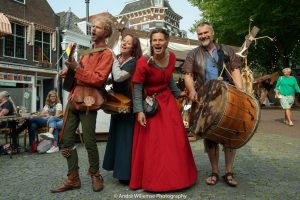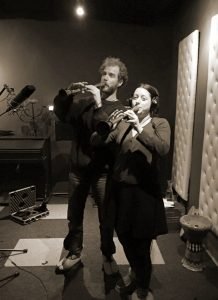
Anno Domini MMVI (In the year of the Lord 2006), Nynke Glazema, Tom Haage, Francesco Scafidi and Lies Sommer formed the Dutch band Datura. Their aim was to bring authentic medieval music to life, wearing the right clothing and each playing the instruments typical of the time:
Nynke : viella* and vocals
Tom : Spanish lute, flute, shawm* and vocals
Francesco : davul*, darbukka*, tambourine, saz* and vocals
Lies : harp, hurdy-gurdy, shawm and vocals
They studied the old manuscripts on the subject: songs collected by King Alfonso the 10th of Castilia y Leon (1221-1284); songs of devotion collected in the Llibre Vermell de Montserrat; the red book of the monastery of Montserrat around the 14th century; and the most famous collection of them all, the Carmina Burana.
The fruit of their studies were recorded for the first time in 2012 with Fieke van den Hurk, and collected on a magical disk-like mirror. A ‘mirror’ they called Alpha et Omega. The songs on Alpha et Omega were partly recorded in two churches and Fieke used the acoustics in there to her full advantage, therefore giving the listener a feel for the sounds of old medieval times. When minstrels would grace the courts and castles of medieval lords and kings. When their music would fill the big halls during elaborate dinners. Where the nobility would stride elegantly in couples to the sound of the music. They strode, because hopping and dancing was for the common people. That´s how Alpha et Omega feels when you listen to it. Elegant, sophisticated and well crafted. A real view into the noble courts of the 12th to the 15th century.
In 2016 Datura visited Fieke in the studio again. From the first notes it’s clear she gave Datura a different sound on Gratus et Optatus. More direct. Where the first album was for the nobility, this ‘magical mirror’ is meant for the common people. It invites you to dance and stomp and sing along. We are not looking into the medieval world anymore. We are right in it! In the midst of it. The travelling musicians are right there in front of us, on the market square, playing their first song Bacche Bene Venies. With Bacchus, the god of wine, standing next to us, giving us another glass. Bacche Bene Venies is a cheerful uptempo drinking song, coming from the Carmina Burana, that gets us listeners going straight away. A musical party to get our skirts swirling and our feet flying off he ground.
The second song, Winder Wie Ist Nu Dein Kraft, is a ballad composed by the 13th century Bavarian minnesinger Neidhart von Reuental written in old German. I quote from the booklet: “He turned away from the refined ethos of courtly, romantic love and wrote in a sarcastic but quite comical manner, mostly about the lower classes.” In this case the song is about the advantages and the disadvantages of marriage. It has all the goodness of a Datura song. Beautiful harp playing by Lies Sommer, a lovely violin solo and last but not least the wonderful combination of their voices. In this case of Nynke Glazema and Francesco Scafidi. Both have really strong voices and they work so well together. One of my favourite songs on the album.
La Rosa Enflorece is just as beautiful. This time Datura visits the courts of Andaluz, in a time when the Moorish courts ruled there. Also a time of the Medieval idea of convivencia (in English coexistance), the idea that all religions can live and work together in peace. Something we ‘modern’ people could learn something from. The song indeed has an Arabic feel to it and is sung beautifully by Tom Haage. He puts so much emotion in this love song. You feel a real sense of longing for a long-lost love.
 Riu Riu Chiu is a cheerful uptempo song. Here all the voices of Datura blend together so well, driven by Francesco´s cheerful percussion. The fun shawm tunes makes this song into a real crowd-pleaser.
Branle Des Chevaux is another fun dance song. In the booklet it is explained that this song should be danced in a horse-like manner. Well, you can definitely hear that in this instrumental song.
Riu Riu Chiu is a cheerful uptempo song. Here all the voices of Datura blend together so well, driven by Francesco´s cheerful percussion. The fun shawm tunes makes this song into a real crowd-pleaser.
Branle Des Chevaux is another fun dance song. In the booklet it is explained that this song should be danced in a horse-like manner. Well, you can definitely hear that in this instrumental song. Dei Patris Unice is an a cappella song by all Datura members. Alle psallitte cum luya is also often sung a cappella by Francesco and Tom during the live shows. But in this case it’s given a beautiful intro solo by Anne Dekker on her viola da gamba*. The melody is taken over by the shawm, before the men bring out their impressive a cappella harmonies and canons. Another personal favourite!
The instrumental song Virgen Santa Maria takes us back to the Moorish courts ruling parts of 13th century Spain and Portugal for the second time, as Datura play this Galician song with Moorish style improvisations. Especially Tom’s intro on the Spanish lute is particularly lovely.
 Schoonlief is a ballad based on a song found in
‘Het Antwerps Liedboek‘,
a songbook from the city of Antwerp. Now a Belgian city, it used to be part of the Netherlands in the 16th century. As Datura describe in the booklet, it is a song with cheeky lyrics. A young man from a poor family tries to conquer the heart of a young noblewoman. Not one dirty word is said…., but for those who listen the message is clear enough!
Schoonlief is a ballad based on a song found in
‘Het Antwerps Liedboek‘,
a songbook from the city of Antwerp. Now a Belgian city, it used to be part of the Netherlands in the 16th century. As Datura describe in the booklet, it is a song with cheeky lyrics. A young man from a poor family tries to conquer the heart of a young noblewoman. Not one dirty word is said…., but for those who listen the message is clear enough!The song itself is a duet between Tom and Nynke. Again those voices blend so well together. I also have to mention the lovely intro, a duet between harp and viella. Or the interlude, another duet, this time between Anne Dekker’s viola da gamba and Tom’s flute. To end it, we get a last beautiful flute and viella solo. Datura’s best song on Gratus et Optatus!
Alas, we get no time to dream about strong handsome young men or beautiful noblewomen. The shawms shake us up for a cheerful Virelai (a type of old French rhyme, the others being the ballade and the rondeau) called Douce Dame Jolie. I know this song in many versions, most of them instrumental. And I have to say that I really like this vocal version. Another cheerful dance song for the common people to jump on, or for the nobility to strode. Just what takes your fancy.
We keep on dancing with Zou Een Meiske Gaan Om Wijn (Should a girl go out for wine). A fast uptempo song with almost a rock feel to it. It gives a fair warning in it’s lyrics, which is explained by Datura in their booklet. Almost every song gets an extensive explanation about its history and subject, making it really interesting to read it all. I happily used a lot of that knowledge in this review.
Gatus et Optatus ends with three more songs. Two ballads, Belle Qui Tiens Ma Vie and Je Nus Hons Pris, a song written by Richard the Lionheart, ending with a last happy dance song, the Danse Moresque.
All in all Datura did way more than just record a piece of history on this CD. They really brought the old medieval songs to 21th century. The music has the same cheerfulness and energy as many a Pagan folk band we can see on the big fantasy festivals. It is as much part of our history as the old Celtic myths and music. It will make a fine musical soundtrack for a wonderful Balfolk night. And I’m sure it will appeal to those who like the classical and eastern influences of a band like Cesair. So if you see them announced, go pay them a visit. Enjoy their music, their spirit and afterwards get one of those magical silver mirrors. Or better yet, buy them both!
– Cliff
– Studio photo’s courtesy of Datura
– live photo courtesy of Andre Willemse
* some explanation of the different instruments:
– A viella is a medieval violin. similar to the modern one. It has a somewhat longer and deeper body and 3 to 5 strings.

– A shawm is a wooden double reed wind instrument, that ends in a flared bell, somewhat like a trumpet. It also sounds a wee bit like a trumpet. Nowadays there are often bagpipes added to the shawm to make it even stronger/louder. Corvus Corax and In extremo are well known for making this version of the shawm popular.
– A davul is a type of big drum carried in front of the player.
– A darbuka is a small goblet formed drum you play with your hands. It looks like a small djembe. It originates from the middle eastern region and eastern Europe.
– A saz is a Turkish guitar that looks a bit like a lute.
– A viola da gamba is a string instrument that looks a wee bit like a cello but is actually a relative of the guitar, most popular in the renaissance and the baroque era. The bow is also held differently than a cello’s. You hold it like you hold the bow of a nyckelharpa.